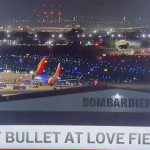Authored by Forrest Marrion via RealClearPolitics,
In the mid-1990s, Brig. Gen. Terryl J. Schwalier “was a rising star in the Air Force,” as Dr. Rebecca Grant wrote in 2006. A decade earlier, in June 1996 he was finishing his one-year tour as a provisional wing commander in Saudi Arabia and was slated for promotion to major general. Then disaster struck. On June 25, 1996, a terrorist truck-bomb – “unprecedentedly large” – exploded outside the building in which his airmen were billeted. Nineteen died. Two hundred forty were wounded. Khobar Towers was among the worst losses of U.S. Air Force life at a deployed location in a single hostile incident in memory. In the investigation that followed, defense secretary William Cohen faced political pressure to assign blame. He buckled, going against his military advisors’ counsel, and, instead, denying Schwalier his second star. The scapegoated general retired.
The decision was unjust in the eyes of many in the know. For starters, Schwalier had not been lax in terms of “force protection (FP).” In fact, he had implemented some one hundred thirty separate FP measures during his deployment and made nearly all the changes recommended by a vulnerability assessment. As the writer recalls, Schwalier’s story and the tragedy of Khobar Towers was part of the assigned readings at the Air Force’s Air Command and Staff College the following year. Furthermore, a key part of the Pentagon’s “outside probe” headed by a retired four-star was badly flawed on the size of the bomb used. The actual bomb – containing “at least 20,000 pounds of TNT” according to the Defense Special Weapons Agency – was at least four times larger than stated in the report, skewing further the judgment against Schwalier. In the years after Schwalier’s retirement, several attempts to overturn the denial of his promotion fell short.
In July 1997, days prior to the announcement of Cohen’s decision to deny Schwalier his promotion, Air Force chief of staff General Ron Fogleman resigned. He did so based on principle, stating to Aerospace Power Journal, “I just could not begin to imagine facing the Air Force after Secretary Cohen made the decision to cancel General Schwalier’s promotion.” In another forum, the chief stated, “I simply lost respect and confidence in the leadership that I was supposed to be following.”
For the record, I have zero relationship with the brigadier general. About ten years ago I was privileged to meet General Fogleman – though unplanned – at the top of the escalator outside the Pentagon, as each of us waited to meet someone. We had three minutes together. Even those who have never met General Fogleman hold him in highest regard. He is universally respected and admired. As far as I know, he was the last four-star to resign on principle.
We need more like him. In the last several years, as more and more are realizing – or at least are finding the courage to speak up – the Air Force has lost its way. Despite the Service infamously prioritizing its pilots’ pigmentation over their proficiency – claiming “too many white pilots” – based on leadership’s commitment to a racist ideology (DEI), how many senior officers have resigned as General Fogleman did?
Meanwhile, following President Trump’s reelection, some, like retired one-star and former defense policy senior official Anthony Tata, are reporting, “The Pentagon is hyper politicized and needs a thorough vetting to include senior active duty military personnel” who are participating in discussions on how to undermine the new administration. National security reporter Haley Britzky, warns, “Pentagon officials are having informal conversations about how the [defense department] would respond if Donald Trump issues orders to deploy active-duty troops domestically [or] fire large swaths of apolitical staffers.” This is not news, but common knowledge.
Precedent exists for holding special administrative boards to determine who stays and who goes among Air Force (and all Services’) senior leaders once the new Trump administration takes over. Recently I wrote about General George C. Marshall’s “plucking board” at the outset of World War Two (RealClearDefense, Sep. 26, 2024). As the U.S. Army chief of staff, Marshall was finally in a position to address the seniority system both he and the Army had long suffered under. As the army expanded in 1940 and ‘41 Marshall built a command system “to be able to put my finger on the man I wanted” for particular leadership posts. Marshall biographer Forrest Pogue wrote, “. . . he was preparing an army for war and felt that the selection of those who could lead in battle was a duty he owed the state.”
To ensure impartiality in the process of eliminating unfit senior officers from consideration for higher-level and combat commands, Marshall appointed six retired officers, headed by his predecessor, General Malin Craig. Marshall’s plucking board was “empowered to remove from line promotion any officer for reasons deemed good and sufficient.” Those removed were given one year to retire. As Marshall told the board, “Critical times are upon us.”
We’re in the same boat today. Except that today’s threats come not only from overseas: since the Obama administration, our once-professional military has been politicized, thanks to neo-Marxist ideology, personal enmity, or misguided judgment.
As the above warnings from knowledgeable Pentagon observers indicate, the second Trump administration will need to conduct a thorough house-cleaning of the military officer corps, many of whom wear stars. This is where Brig. Gen. Terry Schwalier comes in. For the Air Force, arguably there are few (if any) retired senior officers as well-suited to join, or lead, a plucking board.
As one lifelong leading aerospace historian and scholar writes:
You want people who can think beyond their service, who don’t have a grudge and “score-settling” attitude . . . who are in their late 60s and 70s to give them detachment, who are recognized stand-outs, and preferably 3 or 4-star so they have “big picture” experience. Finally, and most importantly, all should be combat veterans AND combat commanders.
He adds: Schwalier “meets the criteria.” Should the President decide on that course of action and bring Schwalier back on active duty, promotion to 3-stars is most appropriate.
As in 1940, the United States faces rogue actors abroad, this time led by China and several lesser would-be aggressors. As countless military historians and others observe, leadership remains the key to authentic deterrence based on strength, and, should deterrence fail, to military success. Having decided to prioritize wasteful, degrading, and morale-killing pursuits such as diversity-equity, searching for imagined extremists in the ranks, and identity politics instead of merit-based combat readiness and unit cohesion, the current Air Force and Pentagon senior leadership must be vetted, corrected, or sent into retirement following a professional, impartial, timely evaluation. The clock is ticking before a real fight reveals very quickly that every DEI program and billet was terribly misguided and a waste of money that was needed for combat readiness.
To borrow the term of Marshall’s day, the senior officers complicit in such priorities and activities, are unfit. Whether it’s by a Schwalier-led plucking board or otherwise, they need to go.
Forrest L. Marion is a retired Department of the Air Force military historian. His most recent work is Standing Up Space Force: The Road to the Nation’s Sixth Armed Service (Naval Institute Press, 2023).
Loading…










